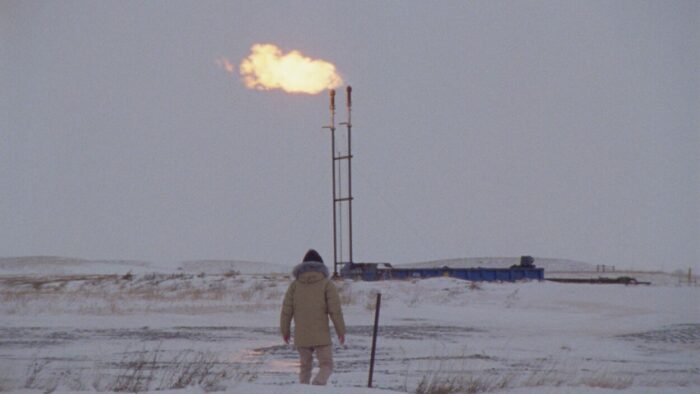Radical, independent film-making at its most visceral, unapologetic and relevant, How to Blow Up a Pipeline is neither dry treatise nor sanitized fluff. Instead it’s a tightly constructed, surprisingly twisty thriller following a group of people the film whose actions the film unhesitatingly endorses. Eco-terrorism and environmentalism in general have been given scant portrayal onscreen, with depictions mostly relegated to films like First Reformed, more about agony and despair than activism, or like Kelly Reichardt’s Night Moves, about the questionable morality of its protagonists. Eco-terrorism on the scale these films depict is rare because environmental activists care deeply about the consequences of their actions. The protagonists of How to Blow Up a Pipeline, however, have nothing to lose but their own lives, which are less important to many of them than solving the problem that will destroy the world as we know it.
The disparate characters of How to Blow Up a Pipeline each have very different perspectives and arrive at their fateful rendezvous leaving very different lives behind them. There’s their leader Xochitl (Ariela Barer), grown disillusioned with ineffectual non-violent activism and determined to make a difference somehow. Theo’s (Sasha Lane) body was poisoned by corporate irresponsibility and clear-headed about dealing justice to the institutions responsible, even as her worried girlfriend Alisha (Jayme Lawson) looks on. Michael (Forrest Goodluck) was driven from his home by big oil and is perhaps a little too prepared to sacrifice everything to get revenge.

And then there’s Logan (Lukas Gage) and Rowan (Kristine Froseth) and for a while, I considered their presence to be the film’s one glaring flaw. In a lineup of committed, responsible, clear-thinking adults, these two eternal screw-ups stick out like a sore thumb. Why the rest of the team would tolerate these two slackers, let alone give them personal responsibility for their mission is a question you’re screaming at the screen for a good portion of the film as they seem nothing more than a blatantly contrived and useless spanner suspended precariously over the works. Don’t worry, they’re going somewhere with this, it’s a cunning sleight of hand, I just perhaps wish it had paid off more meaningfully after such a protracted and frustrating buildup.
I’ve seen some compare How to Blow Up a Pipeline with Reservoir Dogs and yes, there is something about the film’s flashback structure, heist-style narrative and moments of revelation that does echo that film. But stylistically and tonally, I was put more in mind of William Friedkin’s masterpiece Sorcerer, as it assembles its crew of near strangers and puts them on the road with a couple of oil drums full of volatile high explosives. The atmosphere of dread is so thick the chemical fumes might give you a headache just from watching.
The film opens as the crew assemble from across the United States, each one securing their alibi or saying goodbye to their loved ones. As preparations begin, we start to see flashbacks exploring their motives and personalities, each one arriving at a dramatic crescendo as a hand slips or a strap breaks and their lives are momentarily held in suspense. It’s a devious tactic, teasing further tension out of some already nail-biting moments, reinforcing how often our heroes are taking their lives in their hands, and in each others’.

The film’s collaborative, co-operative nature is signaled by the cast and crew list, in which many of its stars perform double or triple duty as writers or producers—if this is where Sasha Lane’s Hellboy paycheck went, it was probably just about worth it—and credits to its ‘anonymous’ technical advisor, who presumably provided the production with the titular insider knowledge. This approach kept the production free from ethical compromise and corporate oversight and its makers’ hands as clean as possible. Despite the thorny subject matter, How to Blow Up a Pipeline stands resolute and keeps its moral high ground.
The film’s source material, the book by Andreas Malm, was not a novel or fictionalized account of true events, but a manifesto arguing for direct attacks on infrastructure to force fast, radical change. The film doesn’t overplay that argument or go in for verbose intellectual debate though, it aims to show audiences what the book attempts to explain to them, and while much environmentalist media is alternately despairingly bleak and unconvincingly hopeful, How to Blow Up a Pipeline has the visceral quality of direct action burned into its 16mm celluloid, seeking to empower and radicalize its audience from the outset. Some have dismissed it as dangerous ‘propaganda’, and…yeah, I don’t think anyone involved would even deny that.
I think Goldhaber, Malm, and the others would embrace the title of ‘propagandists’ as willingly and unapologetically as their characters do the one of ‘terrorists’. If I praise the movie and tell people to see it, listen to it, embrace its ideals and if possible, put them into action, does that make me a propagandist? It knows any viewer it will reach is already aligned with its aims and ideals, what it wants to do is give them that final push, a muster point for like-minded could-be activists willing to do more than talk about saving the world and cosplay as revolutionaries. It’s doubtful its attempt to shake viewers out of their complacency will yield much fruit—I know I’m not likely to make a fertilizer bomb any day soon—but it’s a purposeful swing of a small axe.



